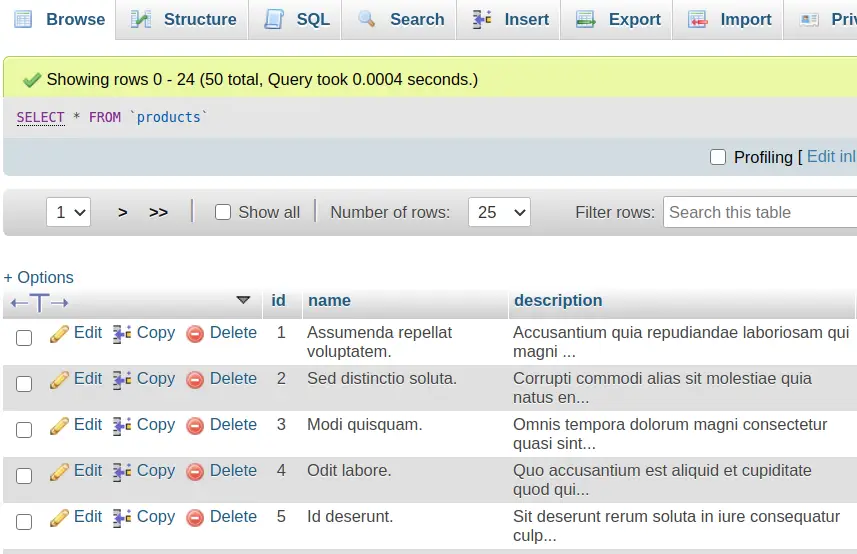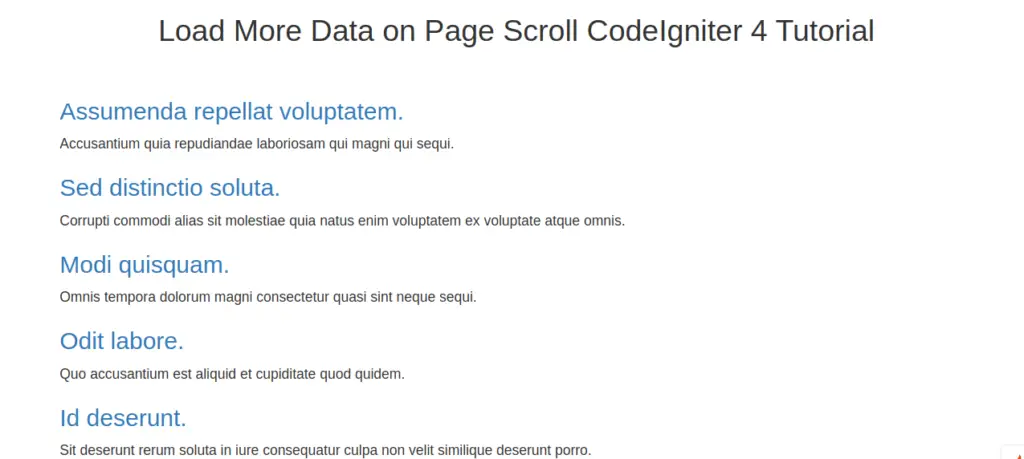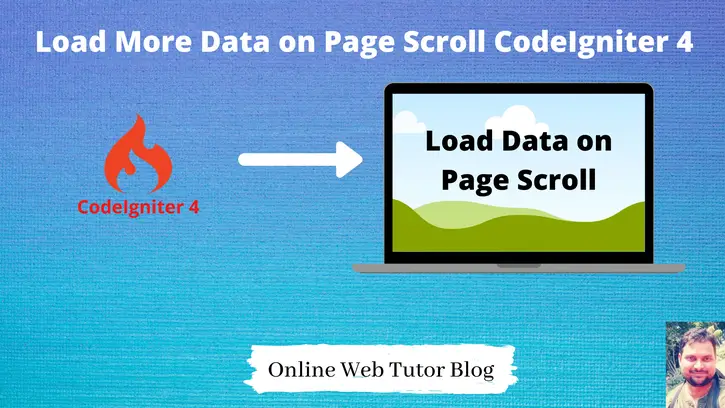Suppose we have a large data set. Loading all data at once in a datatable or in a page results page crash or application will not work. To fix this issue we have several different different solutions.
Here, we have some other useful articles to load more data.
- Loading data by using server side datatable concept, Click here to learn.
- Using SSP Library in CodeIgniter 4, Click here to learn.
- Load data on page when page scrolls.
Inside this article, we will see the concept of Load More Data on Page Scroll CodeIgniter 4. This article is very very easy to learn and implement in codeigniter 4 application.
We will implement the concept of data loading on page scroll in CodeIgniter 4.
Learn More –
- How Throttler and Rate limiting work in Codeigniter 4
- How to Create CodeIgniter 4 Custom Library?
- How to Create Custom Validation Rule in CodeIgniter 4 ?
- How To Create Logs Into CodeIgniter 4 ?
Let’s get started.
CodeIgniter 4 Installation
To create a CodeIgniter 4 setup run this given command into your shell or terminal. Please make sure composer should be installed.
composer create-project codeigniter4/appstarter codeigniter-4Assuming you have successfully installed application into your local system.
Environment (.env) Setup
When we install CodeIgniter 4, we will have env file at root. To use the environment variables means using variables at global scope we need to do env to .env
Either we can do via renaming file as simple as that. Also we can do by terminal command.
Open project in terminal
cp env .envAbove command will create a copy of env file to .env file. Now we are ready to use environment variables.
Enable Development Mode
CodeIgniter starts up in production mode by default. You need to make it in development mode to see any error if you are working with application.
Open .env file from root.
# CI_ENVIRONMENT = production
// Do it to
CI_ENVIRONMENT = developmentNow application is in development mode.
Create Database
To create a database, either we can create via Manual tool of PhpMyadmin or by means of a mysql command.
We will use MySQL command to create database. Run this command into Sql tab of PhpMyAdmin.
CREATE DATABASE codeigniter4_app;Successfully, we have created a database.
Create Database Tables
Next, we need to create a table inside database.
CREATE TABLE products (
id int(5) unsigned NOT NULL AUTO_INCREMENT,
name varchar(100) NOT NULL,
description text,
PRIMARY KEY (id)
) ENGINE=InnoDB DEFAULT CHARSET=utf8;Database Connection
Open .env file from project root.
Search for DATABASE. You should see the connection environment variables into it. Put your updated details of database connection string values.
#-------------------------------------------------------------------- # DATABASE #-------------------------------------------------------------------- database.default.hostname = localhost database.default.database = codeigniter4_app database.default.username = admin database.default.password = admin database.default.DBDriver = MySQLi database.default.DBPrefix = database.default.port = 3306
Now, database successfully connected with the application.
Create Data Seeder
Open project into terminal and run this spark command to create seeder file.
$ php spark make:seeder Product --suffixIt will create a file ProductSeeder.php at /app/Database/Seeds folder.
Open ProductSeeder.php and write this code into it.
<?php
namespace App\Database\Seeds;
use CodeIgniter\Database\Seeder;
use Faker\Factory;
class ProductSeeder extends Seeder
{
public function run()
{
for ($i = 0; $i < 100; $i++) {
//to add 10 products. Change limit as desired
$this->db->table('products')->insert($this->generateProducts());
}
}
private function generateProducts(): array
{
$faker = Factory::create();
return [
'name' => $faker->name,
'description' => $faker->sentence(6)
];
}
}Seed data into database table
Run spark command to seed data into respective table.
$ php spark db:seed ProductSeederCommands will seed data into products table.

Create Controller
Open project into terminal and run this spark command to create controller file.
$ php spark make:controller Site --suffixIt will create SiteController.php at /app/Controllers folder.
Open SiteController.php and write this code into it,
<?php
namespace App\Controllers;
use App\Controllers\BaseController;
class SiteController extends BaseController
{
private $perPage = 10;
public function __construct()
{
$this->db = db_connect();
}
public function index()
{
$builder = $this->db->table("products");
$count = $builder->countAllResults();
if (!empty($this->request->getVar("page"))) {
$start = $this->request->getVar("page") * $this->perPage;
$query = $builder->limit($start, $this->perPage)->get()->getResult();
$data['products'] = $query;
$data['count'] = $count;
return view('ajax_product', $data); // dynamic product list
} else {
$query = $builder->limit($this->perPage, 0)->get()->getResult();
$data['products'] = $query;
$data['count'] = intval($count / $this->perPage);
return view('products', $data);
}
}
}- private $perPage = 10; – When we scroll page, 10 rows load at a time.
- $builder = $this->db->table(“products”); – Creating a query builder instance
- $count = $builder->countAllResults(); – Count total products in table
- $this->request->getVar(“page”) – Read request variable “page”
- $query = $builder->limit($start, $this->perPage)->get()->getResult(); – Get total products on the basis of offset and limit.
Create Layout Files
Create products.php and ajax_product.php files at /app/Views folder.
When we open products list products.php file will be loaded first, while scrolling ajax request will create dynamic product list on the basis of offset and limit and uses layout ajax_product.php and appends to the products.php page.
Open products.php and write this complete code into it.
<!DOCTYPE html>
<html>
<head>
<title>Load More Data on Page Scroll CodeIgniter 4 Tutorial</title>
<link rel="stylesheet" href="https://maxcdn.bootstrapcdn.com/bootstrap/3.3.7/css/bootstrap.min.css">
<script src="https://ajax.googleapis.com/ajax/libs/jquery/3.3.1/jquery.min.js"></script>
</head>
<body>
<div class="container">
<h2 class="text-center">Load More Data on Page Scroll CodeIgniter 4 Tutorial</h2>
<br />
<div class="col-md-12" id="ajax-post-container">
<?php foreach ($products as $product) { ?>
<div>
<h3><a href="#"><?php echo $product->name ?></a></h3>
<p><?php echo $product->description ?></p>
</div>
<?php } ?>
</div>
</div>
<script type="text/javascript">
var page = 1;
var total_pages = <?php print $count ?>;
$(window).scroll(function() {
if ($(window).scrollTop() + $(window).height() >= $("#ajax-post-container").height()) {
page++;
if (page < total_pages) {
loadMore(page);
}
}
});
function loadMore(page) {
$.ajax({
url: '?page=' + page,
type: "GET",
beforeSend: function() {}
})
.done(function(data) {
$("#ajax-post-container").append(data);
});
}
</script>
</body>
</html>Open ajax_product.php and write this complete code into it.
This layout will be used to attach dynamic products when we do page scroll. This file is called inside controller.
<?php foreach($products as $product){ ?>
<div>
<h3><a href="#"><?php echo $product->name ?></a></h3>
<p><?php echo $product->description ?></p>
</div>
<?php } ?>
Create Route
Open Routes.php from /app/Config folder. Add this route into that file.
// ...
$routes->get("products", "SiteController::index");
//...
Application Testing
Open project terminal and start development server via command:
php spark serveURL: http://localhost:8080/products

We hope this article helped you to Load More Data on Page Scroll CodeIgniter 4 Tutorial in a very detailed way.
If you liked this article, then please subscribe to our YouTube Channel for PHP & it’s framework, WordPress, Node Js video tutorials. You can also find us on Twitter and Facebook.
